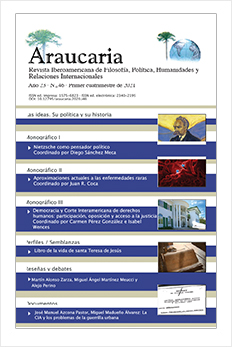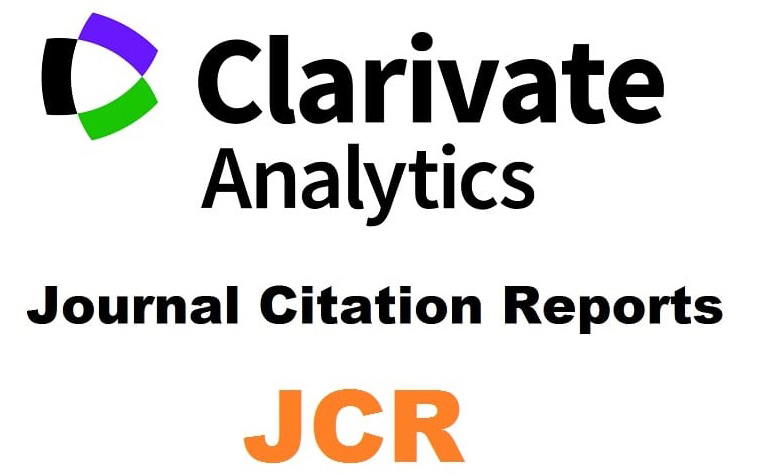Enfermedades priónicas: historia, diversidad e importancia socioeconómica como paradigma de las Enfermedades Raras
DOI :
https://doi.org/10.12795/araucaria.2021.i46.21Mots-clés :
priones, enfermedades raras, enfermedades priónicasRésumé
Las enfermedades raras son aquellas patologías que afectan a una proporción muy reducida de la población (menos de 50 casos por cada 100 000 personas). Por esta razón, la investigación sobre sus causas y mecanismos, algo imprescindible para dar con una forma de tratarlas o prevenirlas, es insuficiente. Por ello, los pacientes denuncien la falta de cobertura del sistema sanitario y la discriminación social que supone padecer una de estas patologías. Entre las enfermedades raras, se encuentran las denominadas enfermedades priónicas o encefalopatías espongiformes transmisibles. A pesar de ser relativamente conocidas gracias a la crisis sanitaria que supuso el “mal de las vacas locas” a finales del siglo pasado, se conoce todavía relativamente poco sobre estas patologías que afectan tanto a animales como a humanos. En este monográfico se pretende dar a conocer la fascinante historia y la diversidad de las enfermedades priónicas, que sacudieron los cimientos de la biología conocida hasta los años 80 al poner en escena a un nuevo y desconcertante tipo de agente infeccioso: los priones.
Téléchargements
Références
Alper, T. (1972). The nature of the scrapie agent. Journal of Clinical Pathology.Supplement (Royal College of Pathologists), 6, 154-155.
Benestad, S. L., et al. (2016). First case of chronic wasting disease in europe in a norwegian free-ranging reindeer. Veterinary Research, 47(1), 88-016-0375-4. doi:10.1186/s13567-016-0375-4
Bonda, D. J., et al. (2016). Human prion diseases: Surgical lessons learned from iatrogenic prion transmission. Neurosurgical Focus, 41(1), E10. doi:10.3171/2016.5.FOCUS15126
Brown, P. (2009). Reflections on a half-century in the field of transmissible spongiform encephalopathy. Folia Neuropathologica, 47(2), 95-103. doi:12704
Brown, P., et al. (2012). Iatrogenic creutzfeldt-jakob disease, final assessment. Emerging Infectious Diseases, 18(6), 901-907. doi:10.3201/eid1806.120116
Budka, H., et al. (1995). Neuropathological diagnostic criteria for creutzfeldt-jakob disease (CJD) and other human spongiform encephalopathies (prion diseases). Brain Pathology, 5(4), 459-466.
Bueler, H., et al. (1993). Mice devoid of PrP are resistant to scrapie. Cell, 73(7), 1339-1347. doi:0092-8674(93)90360-3
Coca, J. R., et al. (2019). Análisis cualitativo del impacto social y familiar de las encefalopatías espongiformes transmisibles humanas. Revista De Neurología, 69, 242-248. doi:10.33588/ rn.6906.2019122
Cohen, F. E., & Prusiner, S. B. (1998). Pathologic conformations of prion proteins. Annual Review of Biochemistry, 67, 793-819. doi:10.1146/annurev.biochem.67.1.793
Collinge, J., et al. (1996). Molecular analysis of prion strain variation and the aetiology of 'new variant' CJD. Nature, 383(6602), 685-690. doi:10.1038/383685a0
Creutzfeldt, H. (1920). Über eine eigenartige herdförmige erkrankung des zentralnervensystems. Z Gesamte Neurol Psychiatr, 57, 1-19.
Chandler, R. L. (1961). Encephalopathy in mice produced by inoculation with scrapie brain material. Lancet, 1(7191), 1378-1379. doi:10.1016/s0140-6736(61)92008-6
Chesebro, B., et al. (1985). Identification of scrapie prion protein-specific mRNA in scrapie-infected and uninfected brain. Nature, 315(6017), 331-333. doi:10.1038/315331a0
Duffy, P., et al. (1974). Letter: Possible person-to-person transmission of creutzfeldt-jakob disease. The New England Journal of Medicine, 290(12), 692-693.
Duque Velasquez, C., et al. (2015). Deer prion proteins modulate the emergence and adaptation of chronic wasting disease strains. Journal of Virology, 89(24), 12362-12373. doi:10.1128/JVI.02010-15
Erana, H., et al. (2017). Prion-like disorders and transmissible spongiform encephalopathies: An overview of the mechanistic features that are shared by the various disease-related misfolded proteins. Biochemical and Biophysical Research Communications, 483(4), 1125-1136. doi:S0006-291X(16)31430-9
European Commission. (n.d.). Rare diseases. retrieved 2020, nov 7. Https://Ec.Europa.Eu/Health/Non_communicable_diseases/Rare_diseases_en,
FEDER. (n.d.). Federación española de enfermedades raras. Https://Enfermedades-Raras.Org/,
Gajdusek, D. C. (1967). Slow-virus infections of the nervous system. The New England Journal of Medicine, 276(7), 392-400. doi:10.1056/NEJM196702162760708
Gajdusek, D. C., et al. (1967). Transmission and passage of experimenal "kuru" to chimpanzees. Science (New York, N.Y.), 155(3759), 212-214.
Gajdusek, D. C., et al. (1966). Experimental transmission of a kuru-like syndrome to chimpanzees. Nature, 209(5025), 794-796.
Gambetti, P., et al. (2008). A novel human disease with abnormal prion protein sensitive to protease. Annals of Neurology, 63(6), 697-708. doi:10.1002/ana.21420
Gambetti, P., et al. (2003). Sporadic and familial CJD: Classification and characterisation. British Medical Bulletin, 66, 213-239. doi:10.1093/bmb/66.1.213
Gibbs, C. J.,Jr, et al. (1968). Creutzfeldt-jakob disease (spongiform encephalopathy): Transmission to the chimpanzee. Science, 161(3839), 388-389. doi:10.1126/science.161.3839.388
Glatzel, M., et al. (2005). Human prion diseases: Molecular and clinical aspects. Archives of Neurology, 62(4), 545-552. doi:62/4/545
Hadlow, W. J. (2008). Kuru likened to scrapie: The story remembered. Philosophical Transactions of the Royal Society of London.Series B, Biological Scis, 363(1510), 3644. doi:10.1098/rstb.2008.4013
Hill, A. F., et al. (1997). The same prion strain causes vCJD and BSE. Nature, 389(6650), 448-50, 526. doi:10.1038/38925
Hill, A. F., et al. (2003). Molecular classification of sporadic creutzfeldt-jakob disease. Brain, 126(Pt 6), 1333-1346.
Houston, F., & Andreoletti, O. (2019). Animal prion diseases: The risks to human health. Brain Pathology (Zurich, Switzerland), 29(2), 248-262. doi:10.1111/bpa.12696
Huor, A., et al. (2019). The emergence of classical BSE from atypical/Nor98 scrapie. Proceedings of the National Academy of Sciences of the United States of America, doi:201915737
Jakob, A. (1921). Über eigenartige erkrankungen des zentralnervensystems mit bemerkenswertem anatomischem. befunde. (spastische pseudosklerose- encephalomyelopathie mit disseminierten degenerationsherden). Z Gesamte Neurol Psychiatr, 64, 147-228.
Johnson, R. T., & Gibbs, C. J.,Jr. (1998). Creutzfeldt-jakob disease and related transmissible spongiform encephalopathies. The New England Journal of Medicine, 339(27), 1994-2004. doi:10.1056/NEJM199812313392707
Klatzo, I., et al. (1959). Pathology of kuru. Laboratory Investigation; a Journal of Technical Methods and Pathology, 8(4), 799-847.
Konold, T., et al. (2004). Clinical findings in 78 suspected cases of bovine spongiform encephalopathy in great britain. The Veterinary Record, 155(21), 659-666. doi:10.1136/vr.155.21.659
Kovacs, G. G., et al. (2005). Genetic prion disease: The EUROCJD experience. Human Genetics, 118(2), 166-174. doi:10.1007/s00439-005-0020-1
Kretzschmar, H. A., et al. (1995). Codon 178 mutation of the human prion protein gene in a german family (backer family): Sequencing data from 72-year-old celloidin-embedded brain tissue. Acta Neuropathologica, 89(1), 96-98.
Latarjet, R., et al. (1970). Inactivation of the scrapie agent by near monochromatic ultraviolet light. Nature, 227(5265), 1341-1343. doi:10.1038/2271341a0
Liberski, P. P. (2012). Historical overview of prion diseases: A view from afar. Folia Neuropathologica, 50(1), 1-12. doi:18385
Liberski, P. P., et al. (2019). Kuru, the first human prion disease. Viruses, 11(3), 10.3390/v11030232. doi:E232
Linsell, L., et al. (2004). A case-control study of sporadic creutzfeldt-jakob disease in the united kingdom: Analysis of clustering. Neurology, 63(11), 2077-2083. doi:63/11/2077
Mathiason, C. K. (2017). Scrapie, CWD, and transmissible mink encephalopathy. Progress in Molecular Biology and Translational Science, 150, 267-292. doi:S1877-1173(17)30119-9
Minikel, E. V., et al. (2016). Quantifying prion disease penetrance using large population control cohorts. Science Translational Medicine, 8(322), doi:10.1126/scitranslmed.aad5169
Nguengang Wakap, S., et al. (2020). Estimating cumulative point prevalence of rare diseases: Analysis of the orphanet database. European Journal of Human Genetics : EJHG, 28(2), 165-173. doi:10.1038/s41431-019-0508-0
Notari, S., et al. (2014). Transmission characteristics of variably protease-sensitive prionopathy. Emerging Infectious Diseases, 20(12), 2006-2014. doi:10.3201/eid2012.140548
Pattison, I. H., & Millson, G. C. (1961). Scrapie produced experimentally in goats with special reference to the clinical syndrome. Journal of Comparative Pathology, 71, 101-109.
Prusiner, S. B. (1982). Novel proteinaceous infectious particles cause scrapie. Science, 216(4542), 136-144.
Prusiner, S. B. (1989). Scrapie prions. Annual Review of Microbiology, 43, 345-374. doi:10.1146/annurev.mi.43.100189.002021
Saborio, G. P., et al. (2001). Sensitive detection of pathological prion protein by cyclic amplification of protein misfolding. Nature, 411(6839), 810-813. doi:10.1038/35081095
Song, P., et al. (2012). Rare diseases, orphan drugs, and their regulation in asia: Current status and future perspectives. Intractable & Rare Diseases Research, 1(1), 3-9. doi:10.5582/irdr.2012.v1.1.3
Takada, L. T., et al. (2017). Genetic prion disease: Experience of a rapidly progressive dementia center in the united states and a review of the literature. American Journal of Medical Genetics. Part B, Neuropsychiatric Genetics, 174(1), 36-69. doi:10.1002/ajmg.b.32505
Tambuyzer, E. (2010). Rare diseases, orphan drugs and their regulation: Questions and misconceptions. Nature Reviews.Drug Discovery, 9(12), 921-929. doi:10.1038/nrd3275
Tesar, A., et al. (2019). Clinical variability in P102L gerstmann-straussler-scheinker syndrome. Annals of Neurology, 86(5), 643-652. doi:10.1002/ana.25579
Thadani, V., et al. (1988). Creutzfeldt-jakob disease probably acquired from a cadaveric dura mater graft. case report. Journal of Neurosurgery, 69(5), 766-769. doi:10.3171/jns.1988.69.5.0766
Verbeke, W. (2001). Consumer reactions and economic consequences of the BSE crisis. Verhandelingen - Koninklijke Academie Voor Geneeskunde Van Belgie, 63(5), 483-492.
Wang, F., et al. (2010). Generating a prion with bacterially expressed recombinant prion protein. Science, 327(5969), 1132-1135. doi:10.1126/science.1183748
Wickner, R. B., et al. (2015). Yeast prions: Structure, biology, and prion-handling systems. Microbiology and Molecular Biology Reviews : MMBR, 79(1), 1-17. doi:10.1128/MMBR.00041-14
Williams, E. S. (2005). Chronic wasting disease. Veterinary Pathology, 42(5), 530-549. doi:42/5/530
Yuan, A. H., & Hochschild, A. (2017). A bacterial global regulator forms a prion. Science (New York, N.Y.), 355(6321), 198-201. doi:10.1126/science.aai7776
Zlotnik, I., & Rennie, J. C. (1965). Experimental transmission of mouse passaged scrapie to goats, sheep, rats and hamsters. Journal of Comparative Pathology, 75, 147-157.
Téléchargements
Publié-e
Comment citer
Numéro
Rubrique
Licence
Las ediciones impresa y electrónica de esta Revista son editadas por el Secretariado de Publicaciones de la Universidad de Sevilla, siendo necesario citar la procedencia en cualquier reproducción parcial o total.Salvo indicación contraria, todos los contenidos de la edición electrónica se distribuyen bajo una licencia de uso y distribución “Creative Commons Atribución-NoComercial-SinDerivar 4.0 Internacional”








